Although the story of their discovery by Peter Posa in Henderson has them indelibly associated with West Auckland, Judy and Sue were born in Wellington.
Judy: “We lived in Tawa Flat. Mum and Dad both worked in the Customs, they met there in fact. Dad travelled to work on the train every day, we didn’t have a car.”
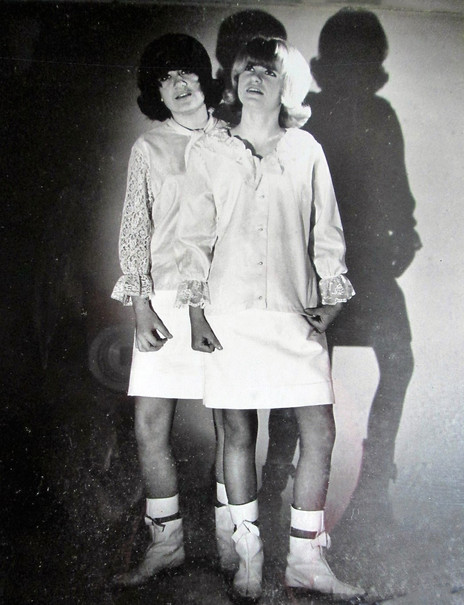
The Chicks. - Judy Donaldson Collection
Sue: “When Judy was about three and I was nine months old, our house burnt down. Grandma left an oily linseed rag in the laundry and it somehow caught fire. My parents both had the flu so they couldn’t smell the smoke.”
Judy: “Mum and Dad were resting. I went in and pulled and pulled on the bed and said, ‘Come and have a look at the big red thing!’ At first Dad said ‘Don’t worry us dear,’ so I went away. I was soon back. ‘The big red thing’s in the kitchen now.’ I was so insistent that Dad had to drag himself out of bed. By now the whole back of the house was on fire.
“The neighbours came and tried to help by getting the piano out but got it stuck in the doorway. Of course, the Wellington wind just went whoosh – straight through the house, so the fire was well away by the time the fire brigade got there.
“I remember standing on the footpath and seeing Dad throwing mattresses and all sorts of things out the window. Sue and I were terrified and hanging tightly on to Mum’s wrist.
“Our parents had no insurance because they simply couldn’t afford it. So they borrowed a truck, loaded up the few belongings that were left and we headed off to Auckland.”
Down on the farm
Sue: “We ended up on a dairy farm in School Road, Waimauku, which our parents purchased with money loaned by our grandmothers. Dad had no idea about farming at all but made his decision on the recommendation of a friend just back from Auckland. It was a small farm that no one had been able to make any money from, so they bought it cheaply.”

Judy and Suzanne Donaldson. - Judy Donaldson Collection
Judy: “We loved it because we got to feed the calves. We had a dog, and lots of cats.”
Sue: “My father had trouble with rats in the barn so he laid down poison pellets. They were bright blue and looked like lollies. I, at the age of three, found these and decided I’d share them with the dog. I ended up in hospital getting my stomach pumped. The poor dog Pat died. I’ve never forgiven myself for feeding him.”
Judy: “Our next move was to a poultry farm in Motu Road, Huapai, about five kilometres from where we’d been in Waimauku. We attended Huapai Primary School and we loved it. Fish and chips day was Friday. The van arrived, you could actually smell it coming.”
Sue: “It was a real country life. We had calf club day for pet lambs and pet calves. Sometimes I rode my pony Smokey to school – put him in the next paddock during the day.”
The girls’ interest in music was instigated by their mum, an accomplished piano player, skilled at harmony singing.
Judy: “Mum was musical – she used to play the piano and teach Sue the tune and me the harmony; Stephen Foster songs were some of the first we learned. By the ages of six and eight we were singing as a duo.”
Judy: “Our next-door neighbour was Kevin Borich, later of The La De Da’s. We used to peek through the hedge at him and think he was just wonderful. He was about one year older than me. He never took any notice of us of course as he was driving the truck around his parents’ orchard.”
Kevin Borich: “My parents had a 15-acre farm that bordered the Donaldsons’. They worked very hard and I had to do my share. Around the age of 12 I started learning a few chords on my guitar. With my parents so busy, Mrs Donaldson became the prime driver of my music playing and singing.”
Sue: “Our families were friends – we used to go next door to the Borichs, gather round the piano. In those days it was the only entertainment. And of course they also came round to our place.”
Kevin: “Mrs Donaldson also had a piano and she was pretty good. It was a short walk over to the Donaldsons where we’d work out songs for the three of us to perform for our parents. The girls were so perfect even at that age – they never seemed to sing a bum note. It was a really joyous thing to do, playing with those two.”
Judy: “We even recorded with him. He brought his guitar in and we sang with him at Astor studios in Shortland Street. I’ve still got that recording – ‘I’m Gonna Knock On Your Door’, ‘Corrina, Corrina’, and ‘Sailor Stop Your Roaming’.”
Kevin: “Around 1960 Mrs. Donaldson drove us into town where we recorded a few songs together – the girls singing doo-wops and harmonies and me on guitar doing my Māori strum. The girls also recorded their version of ‘Pokarekare Ana’. After my mum passed away I found an acetate disc of the recordings in her piano stool. I took it to the Australian National Library who restored it and made a CD for me.”
The sisters had their first taste of the big time whilst on summer holidays.
Judy: “We went on a family holiday to Tauranga. Dad entered us into talent quest at the Soundshell as The Dots. We wore lovely matching polka-dot dresses that Mum had made. We were nine and seven at this time.”
Sue: “We won that talent quest, I remember, singing [Tony Bennett’s] ‘In The Middle Of An Island’, a cappella. Our parents were delighted as the prize was a chicken – very expensive in those days. Then straight afterwards they entered a raffle and won another chicken!”
Judy: “Mum was thrilled so she taught us more songs. We of course just loved it – it was our entertainment.”

The Chicks' first record, as arranged by Mike Perjanik, 1965
The sisters’ reputation as great singers soon became common knowledge at school.
Judy: “Our friends at school used to bail us up quite often, and wouldn’t let us go until we’d sung them a song. Even when the bell rang they’d pin us down; we couldn’t move.”
Sue: “I guess in those days to sing in harmony, and to have the confidence at that age to just stand there and sing, was pretty rare.”
Judy: “I went to Rutherford High School in Te Atatu and didn’t enjoy it at all. Then our parents moved again, this time to Tirimoana Road, Henderson.”
Sue: “Dad had given up on being a farmer.”
Judy: “Our parents had the Penguin Bookshop when we were in Henderson. Dad was studying to be in real estate, while Mum ran the shop. By now we were both at Henderson High.”
As with so many teenagers the world over, The Beatles were a massive influence.
Judy: “On the car radio we could hear The Beatles every morning and we made Dad turn it up loud: ‘I Saw Her Standing There’. He’d drop us off at school then head to the bookshop.”
Sue: “We were coming in around the time of the Beatles. We’d go and line up to buy the next Beatles record at the local record shop in Henderson.”
Judy: “That’s where I worked after I left school: Jorgensen’s. It was a home appliance shop that also had records for sale. I used to order all the pop singles and my boss would say ‘What did you order that for, that’s not going to sell’ and of course they went like hotcakes: The Beatles, The Rolling Stones and all the rest.”
Sue: “Judy ordered in everything we wanted to learn of course.”
Sue: “Once we were in Henderson we got in to a little school band called The Ravens. I was in the first year, third form at this stage. We sang whatever was popular, all covers.”
Judy: “We sang at a school dance, I remember, and once again we had outfits: black dresses with red sashes.”
Sue: “Butch Berryman was the drummer – I had a bit of a crush on him … ”
Judy: “… and his brother Gary Berryman was the guitarist.”
Sue: “We used to be a garage band before they became known as garage bands – we rehearsed in the Berrymans’ garage.”
In 1965 a chance encounter was to change their lives forever.
Sue: “One day Judy, who was a big fan of what was hot, heard live music coming from next door.”
Judy: “I heard somebody playing a guitar and realised it was Peter Posa. He lived in Henderson and was just visiting a friend, our neighbour – playing a few tunes on the deck on a sunny afternoon.”
Sue: “I remember you running back and telling us who it was. We were with school friends, hiding behind a bush. They were saying: ‘Go on – you go and ask him for an autograph.’ ‘No you go, you go.’ We decided that we’d all go up together and ask Posa for his autograph.”
Judy: “The other girls that were with us said to Posa: ‘You should hear these girls sing, they’re good.’ ”
Sue: “Posa replied: ‘Okay sing me a song and I’ll give you an autograph.’ We sang him ‘Tobacco Road’ and ‘I Don’t Want To Spoil The Party’ – which was an odd pick as they were actually having a party. Posa played along with us; he knew the songs of course. And we did actions that I had made up to go with the songs.”
Peter Posa (speaking to the Auckland Star, 15 June 1965): “I was astonished by their natural ability to harmonise.”
The combination of harmony singing and dancing impressed Posa’s manager and Viking Records co-owner Ron Dalton, also present that day.
Judy: “We always danced when we sang. Dalton thought it was quite unusual. He was about to launch Dinah Lee in Australia and was looking for a new act for the New Zealand market.”
Sue: “He asked us if we’d like to come in to Viking Studios for an audition. I remember he wrote our phone number down on the back of a cigarette packet.”

The Chicks were discovered by Viking's Ron Dalton while singing for Peter Posa. They would provide Viking with a string of hits.
Judy: “It was like a fairytale. We were so excited we ran home and told Mum and Dad of course.”
Sue: “Mum said ‘Oh you’ll never hear from him again – here’s the tea towel, dry the dishes’, basically.”
Judy: “Two weeks went by and Dalton finally rang. He said he had a song chosen and could we come to Mascot Studio (in Newton). We went in one day after school. Sue was still in her school uniform. We were just 14 and 16 years old.”
Dalton chose ‘The Hucklebuck’, a hit for Chubby Checker in 1962, as the first track for the girls to record.
Sue: “Mike Perjanik [later the chairman of APRA Australia] was the musical director and pianist. He’d worked out the arrangements before we got there.”
Judy: “There were no individual takes, we had to do it all together. When we mucked it up, we all had to stop and start again.”
Sue: “It was only a two-track recording. We had to get the one take that was perfect.”
Judy: “Yuk Harrison was the bass player and he had to play a repetitive rhythm flat out. Sue and I recorded our voices twice. When we did the second take he filled in bits on the bass – it was just so fast.”
Sue: “Chris Parkinson [co-founder of Radio Hauraki] did the vocal ‘Hey, heys’ on the track – he married Ron Dalton’s sister.”
Judy: “We also recorded ‘Heart of Stone’. The audition went so well it was decided that we should do other songs and make an album. The audition effectively became our first album.”
Mike Perjanik: “I remember them being young and very enthusiastic, ready to go places – certainly good enough to get a record deal. Ron Dalton produced the album and chose all the tracks. The recordings were done very quickly as of course it was in the days before multi-tracking.”
Judy: “Despite what others may claim, it was Mike Perjanik that gave us our name. Dalton had wanted to call us The Angels but Perjanik constantly yelled out ‘Get those chicks to the microphone’ during the recording session and the name just stuck.”
The Sound Of The Chicks was released in August 1965. Dalton wrote excitedly in the sleeve notes:
“Sue, who sings the lead, is 14 years old and along with her sister Judy, who sings the harmony, are in my opinion headed right for the top. For those who can appreciate close harmony singing their version of ‘Can’t You Hear My Heart Beat’ and the rendition of ‘The Bird And The Bees’ must surely be appreciated. The exciting version of ‘Tobacco Road’ and the feel that these two young girls get into this great song still leaves me with the feeling that they are no doubt in world class. By the time this album is released the girls will have toured with Sandie Shaw and P J Proby and the excitement of their act will have won them many fans. People who have predicted a big future for these girls include Jim Haddleton of General Artists NZ Ltd., John Berry of The Auckland Star, Neville Chamberlain and Ted Thorpe, N.Z.’s national DJs. Switch on the hi-fi and be my guest with The Chicks for a swinging time!”
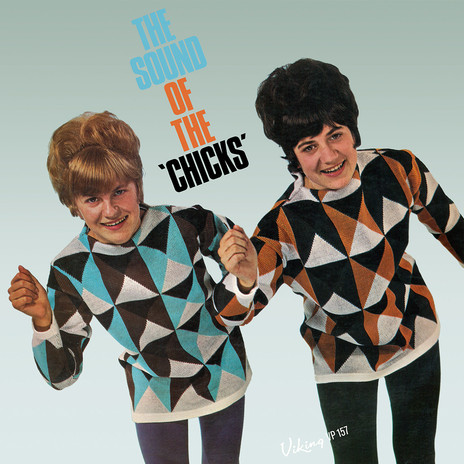
The Chicks' debut album for Viking from 1965, recorded when Sue was just 14 and Judy 16.
Sue: “ ‘Heart Of Stone’ was released as the first single just to break the ice. That got to No.12.”
Judy: “Then ‘The Hucklebuck’ went to No.1.”
Sue: “I can’t remember what chart it was. Maybe we were only No.1 in Putaruru!”
Second single ‘The Hucklebuck’ put The Chicks on the map. The Auckland Star of 28 August 1965 reported: “A National Committee has selected 10 recordings by New Zealand artists as the basis for a radio contest to find the most popular disc of the year. The contest has been organised in association with APRA, NZFPI, and the NZBC. A Golden Disc Award will be selected from public voting.”
From 40 entries submitted, the judges chose ‘The Hucklebuck’ as one of the 10 finalists in the first ever Loxene Golden Disc Awards.
Now signed to a one-year contract with Viking, Dalton effectively became their manager. Records seem to have been regarded as fodder for selling tickets to shows in the 60s New Zealand music scene. With an album in the can and instant success with ‘The Hucklebuck’, Dalton set about preparing The Chicks for live performances and radio and television work.
Judy: “Dalton took us up to Dargaville and for practice we had to perform in the lounge of some of his friends. We sang ‘Heart Of Stone’ and ‘The Hucklebuck’.”
Judy: “I’d made up a little dance for ‘The Hucklebuck’.”
Sue: “Judy made up the dances and I just did as I was told.”
Judy: “We looked good together; it must have been obvious that we loved being on stage.”
Sue: “I looked like the Energizer Bunny on speed. It was because I was so terrified that the energy poured out of me when I got on stage – and it’s still the same now.”
Sue: “In what seemed like no time at all we were lined up for our first TV appearance.”

The Chicks. - Judy Donaldson Collection
Mike Perjanik: “I was musical director for On The Beatside. It was the first ever TV ‘pop’ show in New Zealand. From memory it started in 1963. We recorded at the NZBC studios in Shortland Street. I remember The Chicks made their TV debut on the show.” [Broadcast date 15 June 1965.]
Judy: “We had to be pushed on – our legs were like jelly.”
Sue: “Mine were shaking so much. I was terrified, although we were just miming. The person before us was Ray Woolf singing ‘Mrs. Brown You’ve Got A Lovely Daughter’. He had a little cap on and I thought how fantastic is that. I was so impressed – I’m still good friends with Ray today.”
Judy: “So that was our first TV experience – just the one song – terrifying.”
Sue: “It was all over before we knew it. It was wow! What happened?”
Judy: “Dalton said we needed an ‘image’. He took us to Sonny Elegant Knitwear and chose these fabulous diamond patterned jumpers. They probably just gave them to us as we were going to be promoting the brand. They were long jumpers that came right down to below the hips. We wore them with tights and short black Beatles boots. Whenever we performed we wore those outfits; those jumpers became known as the Chick jumpers.”
Sue: “We quickly became conscious of the importance of our ‘image’. We always dressed the same if we were ever going out.”
Judy: “If we went out to lunch for example we would always wear matching outfits, just in different colours.”
Head Out On The Highway
And so began five years of relentless touring, nightclub shows, radio interviews, TV appearances, newspaper and magazine features, in store appearances, and recording sessions for singles, albums, and even commercials.
Judy: “I became Big Chick and Sue became Little Chick. Our Mum was popular because other artists like Ray Woolf, Ray Columbus, and Larry Morris used to come to our place and Mum would get to know them: ‘Have a cup of tea,’ she’d say. They named her Mum Chick.”
Judy: “Our dear Mum also enjoyed her role as the President of The Chicks’ Fan Club. Family friend Barry Osborne was in charge of our fan club at first, but after a short time he said he was too busy, so Mum Chick took over, but under the pseudonym Jimmy Page. She wrote a newsletter every month, often putting in little known bits and pieces about ‘the girls’. The newsletters went out to over 1000 fan club members. We loved reading our fan mail, and most of it was replied to, either by Mum or us.”
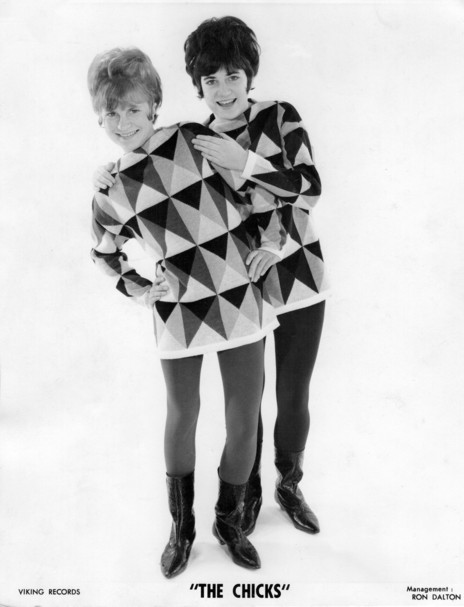
Viking Records talent card for The Chicks. - Judy Donaldson Collection
Sue: “I didn’t turn 15 till December (1965), so I was actually 14 when I started touring. We became friends with many other New Zealand singers and musicians because when we performed in those days there were always about six other artists on the bill. We soon got to know everybody. I used to think the other artists on the tours were so much older than us. In reality they were only 18 or 19 years old. I was quite in awe of them all.”
Sue: “The boys in the bands on the tours always treated us very well, almost like little sisters – in fact I still feel like their little sister.”
Judy: “Many years later one of the boys said to us they’d been given a good talking to before the tours and told: ‘You don’t touch The Chicks’. They never ever did – I mean we were so young but they did look after us very well. It was wonderful, a great experience.”
Larry Morris: “Me and the Rebels toured with The Chicks several times. The girls’ father, John Donaldson, was a lovely man, always very respectful towards me. He certainly made a huge difference in improving my attitude. He always said to me ‘Larry do me a favour will you, keep an eye on those girls, particularly young Suzy.’ So I made it my mission to make sure they were all right. If anyone looked like they were getting out of line I’d sort them out.”
Sue: “I remember touring with Larry Morris, and Shane, and after the show they’d say: ‘Have you got your magazine?’ and then: ‘Now lock the door’; so we’d lock our hotel door and they’d all run off.”
Judy: “We could hear them partying down the hall …”
Sue: … and we’d be there reading our Woman’s Weekly magazine. We used to lie in our beds and wonder what they were doing. On all the tours we were on it was like that.”
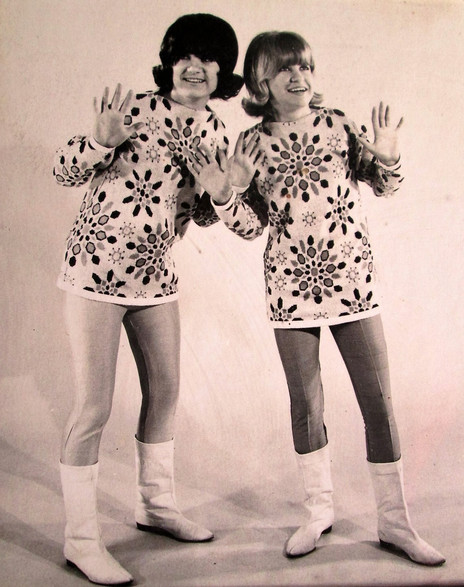
The Chicks. - Judy Donaldson Collection
Larry Morris: “I think Judy was a little miffed at missing out on the action.”
Sue: “The worst they probably did was to drink too many bourbon and cokes. They acted like typical teenagers. All this sex drugs and rock and roll must have been the era after us as it wasn’t obvious on these tours. They were just having fun.”
Judy: “We thought touring was fabulous because we got to travel round New Zealand, and it was non-stop laughter on the bus.”
Sue: “During the day the boys were acting like idiots most of the time – trying to impress us two young girls.”
Judy: “Although often they just slept on the bus because they’d been up all night.”
The Chicks’ first major tour took place in August 1965.
Sue: “It was a package tour of Sandie Shaw, The Pretty Things, Eden Kane, Wayne Fontana and us. Fontana was actually on his honeymoon at the time; he’d bought his wife with him, so they were all lovey-dovey. We were introduced each night by tour compere Neville Chamberlain.”
Judy: “All the artists travelled together on a bus with a backing band. We had a great time.”
Sue: “Mum came with us on this tour because we were so young.”
Judy: “Viv Prince, the drummer of the Pretty Things, pinched Mum’s leopard-skin pillbox hat and wore it for the whole tour. Mum made sure she got it back off him at the end of the tour though.”
Sue: “Prince was a bit of an idiot – he was probably drunk most of the time. The band drank a lot but they were just being hoons. He set fire to the curtains in New Plymouth and got me to play the drums for the Pretty Things while he was doing it.”
Judy: “He lit a piece of newspaper, ran around with it, and then held it really close to the curtains. The crowd thought it was fantastic.”
Sue: “I’d learnt to play the drums when I was in the Ravens. I remember I learnt [The Rise and Fall of] ‘Flingel Bunt’ from the drummer because I fancied him.”
Sue: “The Pretty Things had a bit of a reputation but compared to artists these days they probably weren’t that bad at all.”
Judy: “One of my mother’s comments sums them up well: ‘Oh they’re so lovely those boys. I don’t know how they’ve got the energy – they haven’t slept for 10 days!’ ”
Sue: “They were certainly very nice to us, like the local boys they also treated us like kid sisters.”
Judy: “Sandie Shaw kept to herself, and wasn’t terribly friendly to anyone really – mind you she was only 18. She had her father with her – so she had her dad and we had our mum.”
Sue: “We sang all her harmonies when she was performing; our first ever backing job. We had to go behind a curtain because she wouldn’t have us on the stage. We did our own set and then we did her vocal backing.”
Sue: “The tour lasted about two weeks. I had to get time off school to do it. I left school the day I turned 15. I was out doing gigs and I would come into school and anything that was a bit boring I’d just have a nap. I always remember my mother reading out my school report: ‘Suzanne is a good pupil when awake in class.’ ”
Judy: “And my boss at work wasn’t too happy about me going away either, so we both had to turn professional.”
Judy: “We were only home a few weeks when we were invited on the Dinah Lee tour, so we were away again. It was three weeks with Dinah Lee, Tommy Adderley and Gerry Merito; great memories. Gerry Merito was lovely and Dinah was great fun. It was the same thing again, all together in a bus, though this was just the upper North Island. We were asked to do vocal backings for Dinah but unlike Sandie she wanted us onstage with her. That was an honour. We did our own set then just stood at the side of the stage during Dinah’s set.”
Sue: “It was mostly town halls and opera houses. We were paid a fee per show.”
Judy: “We didn’t really care about the money though, we just wanted to tour. In money matters Dalton dealt with Dad as we were still minors.”
Viking released a live album following the tour entitled Live on the Dinah Lee Show, which featured two tracks by The Chicks, ‘Roll Over Beethoven’ and ‘The Hucklebuck’.
Judy: “The Dinah Lee Show album includes us, Tommy Adderley, and Lonnie Lee, all backed by the Rajahs from Australia. I still love listening to that album, it brings back many happy memories.”
A brief trip to Australia followed.
Judy: “Mum and Dad took us to Australia for a couple of weeks. We appeared on several TV shows, including Kommotion in Melbourne and Saturday Date in Sydney. We then performed at the Sydney Stadium with Max Merritt and The Meteors.”
Sue: “We were also booked on the Normie Rowe show in Newcastle – a live show. Dad drove us up there from Sydney.”
Judy: “Normie Rowe didn’t show up till about 10 o’clock so the support acts all had to go on twice – they got a double dose of The Chicks that night.”
Sue: “We went down really well. As a result of our TV appearances and the Normie Rowe show we were offered lots of work, but it all came to nothing when they realised how young we were. They said: ‘Well you can’t sing in RSL clubs – come back when you’re older,’ and that was the end of that.”
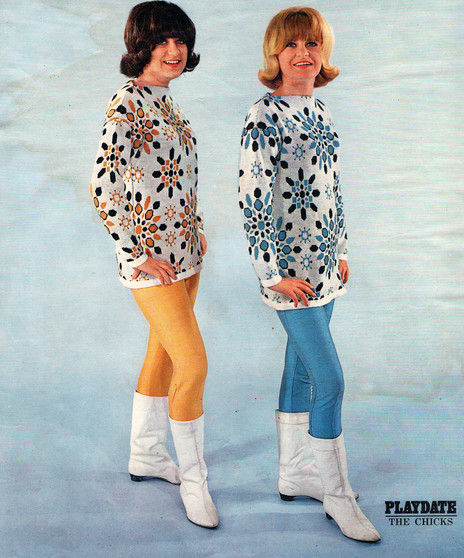
The Chicks, Playdate magazine. - Judy Donaldson Collection
Judy: “We next toured with P J Proby – the one who split his pants – and Eden Kane again. Kane was a lovely guy; we really liked him. He wore a white suit, which was just outrageously good in those days. The girls screamed when they saw him; he was very handsome. ‘Boys Cry’ was his one big hit here. Then P J Proby came out, jumped up doing the splits and tore his pants. We were on stage backing him too. I remember watching him coming off stage. When he came over he had sweat dripping down his matted hair. He was looking at me strangely.”
Sue: “We thought he was going to expire …”
Judy: “… after throwing himself round the stage. I remember patting him on his head, and saying ‘It’s alright PJ!’ ”
Sue: “He had a bit of a reputation. I don’t really know if he was any good or not – you couldn’t hear him for the screaming.”
Sue: “All I remember about him is he used to sit in the back seat of the bus and eat raw steak.”
Judy: “He wouldn’t stay with us in the hotel in Whangarei – he was given the room that the Queen stayed in when she was here in 1953 and he said that it wasn’t good enough, so he slept in the back seat of the bus.”
Judy: “Once again we were put in our room after each show and the door was locked. We could hear them partying down the hall – the story of our lives! This time it was tour promoter Jim Haddleton keeping an eye on us.”
A bewildering variety of one-off shows up and down the country were completed on a weekly basis in between tours. Budding young promoter Mike Corless invited them down to Hawke’s Bay for one such show:
Mike Corless: “I put on an outdoor show on a Sunday afternoon. I’d managed to persuade The Chicks to come down with The Dizzy Limits and headliner Shane. They were very professional. Despite the rain I remember them making their grand entrance to the show in go-karts.”
Time was squeezed into their busy schedule for a second album. The Chicks were flown to Wellington and the album recorded at the HMV studios in Wakefield Street. Music arranging was by Garth Young, and the engineering by Frank Douglas. Entitled the The Chicks 2nd Album, the 12 tracks included a mixture of rock and roll standards and covers of other popular tracks of the day.
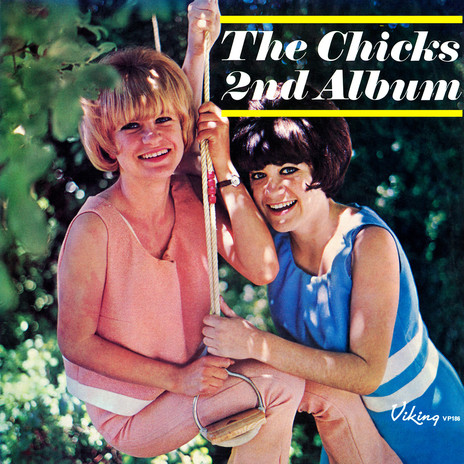
The Chicks' 1966 album produced by Ron Dalton and engineered by Frank Douglas. Cover photograph by Hubert Sieben.
Garth Young: “With so many projects on the go from Viking and HMV, to say nothing of TV programmes, things were an absolute madhouse at this time – but very exciting. The backing musicians for this album were likely to have been Kevin Watson on guitar, Slim Dorward on bass and Dave Fraser on drums.”
Judy: “The second album was my least favourite album. It was recorded in Wellington with different musicians and had a completely different sound and feel to it. It was probably Ron Dalton’s idea – I think he had friends down there. We were just so young we did as we were told.”
Sue: “It sounds pretty good though – I always loved the sound HMV got – the engineer they had there, Frank Douglas, got some terrific sounds out of that studio. He did so much great stuff.”
The Chicks supported Normie Rowe once again, this time at the Crystal Palace in Mt Eden. The Auckland Star of 16 April 1966 reported:
“The Chicks appeared to stomp the rice into the stage with some smooth work.”
In May The Chicks appeared on the TV show A Swingin’ Safari. The Listener reported:
“The Chicks first made a hit on television in A Swingin’ Safari when they combined their singing with a zany marching routine.”
Bruce King (drummer in the Mike Perjanik Band): “The show featured Dinah Lee and Tommy Adderley, The Chicks, Nick Villard, The Convairs, Maxine Adams, Gray Bartlett, Herma Keil, and the Mike Perjanik Band. Ray Columbus and Clyde Scott were the two compéres.”
Judy: “The whole show was filmed in two consecutive days around a lovely swimming pool in front a mansion in Remuera, and was televised in four parts from memory. The Chicks sang ‘Be Bop a Lula’ and ‘Cumala Be Stay’. Sue and I did dance routines for each song that I had choreographed.”
Sue fell seriously ill and was hospitalised for six weeks. So serious was the problem that the duo was unable to undertake any engagements from December 1966 to April 1967. Undoubtedly the punishing live schedule of the previous 18 months was largely to blame.
Judy: “We couldn’t perform live due to Sue contracting tonsillitis. Her tonsils were so infected that they couldn’t take them out. They had a real problem trying to get things to where they could operate. She was ill for a long time; relentless antibiotics eventually got things under control.”
Sue: “I had glandular fever and tonsillitis at the same time. We were continuously on tour, working very hard. There was no foldback in those days so you’d push and push your throat to sing louder, and I was singing incorrectly. I ended up in the Mater Hospital for six weeks. Apparently I had a 50% chance of survival because the glandular fever was stopping the tonsils getting better and the doctors were worried about septicemia. Eventually the tonsils were removed. I couldn’t sing, couldn’t even talk for quite a while.”
Judy: “I heard rumours that people thought the reason we weren’t performing was because I was pregnant, or that Sue was pregnant, and that we were being very quiet about it. I thought this is ridiculous, she’s seriously ill. I rang the newspapers to put it out there that Sue was in Mater Hospital and that she was going to be there for weeks if anybody would like to write to her. We were then absolutely swamped with fan mail. I took it all up to the hospital for Sue to read.”
Sue: “The first night out of anesthetic I was touch and go. I had a very high fever. In the middle of the night three nuns came to my bed. One dressed in black in the front and two in white, all carrying candles. The one in front looked at me and said: ‘Hello dear, I’m going to cross you with holy water. You’re going to be okay – you’ve got far too much to do yet.’ I’ll remember those words for as long as I live. I felt the water run down my face as she made the sign of the cross saying: ‘You’re going to be fine.’
“Weeks later when I could talk properly I said I’d like to thank the nuns that came in the night. The nurses said: ‘There’s no nuns here dear’. I said ‘Yes there were three and they came in the night.’ ‘Oh no dear, there haven’t been nuns here for years and years.’ As I was leaving the hospital there was a big photo of the founding nun in the entrance lobby and I said to my mother ‘That’s the nun that came in the night.’ We went and read the inscription underneath and it was dated 1887.”
Judy: “That was the one that talked to you.”
Sue: “What they said was ‘Oh you must have seen that photo subliminally on your way in to the hospital and conjured that up in your own head.’ But I tell you I felt the water run down my face and I remember those words so well.”
Sue: “I’ve actually got a lovely song about the episode. It’s called ‘Angel Of Mercy’ – it’s never been released. I told Murray Grindlay the story and he wrote the song. I recorded it with him – ‘Angel of mercy, she watches over me.’”
--